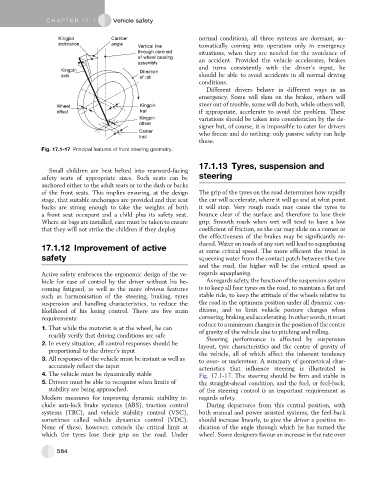Page 573 - Automotive Engineering Powertrain Chassis System and Vehicle Body
P. 573
CHAP TER 1 7. 1 Vehicle safety
Kingpin Camber normal conditions, all three systems are dormant, au-
inclination angle
Vertical line tomatically coming into operation only in emergency
through centroid situations, when they are needed for the avoidance of
of wheel bearing
assembly an accident. Provided the vehicle accelerates, brakes
and turns consistently with the driver’s input, he
Kingpin Direction
axis of roll should be able to avoid accidents in all normal driving
conditions.
Different drivers behave in different ways in an
emergency. Some will slam on the brakes, others will
Wheel Kingpin steer out of trouble, some will do both, while others will,
offset trail if appropriate, accelerate to avoid the problem. These
Kingpin variations should be taken into consideration by the de-
offset
signer but, of course, it is impossible to cater for drivers
Caster who freeze and do nothing: only passive safety can help
trail
these.
Fig. 17.1-17 Principal features of front steering geometry.
17.1.13 Tyres, suspension and
Small children are best belted into rearward-facing
safety seats of appropriate sizes. Such seats can be steering
anchored either to the adult seats or to the dash or backs
of the front seats. This implies ensuring, at the design The grip of the tyres on the road determines how rapidly
stage, that suitable anchorages are provided and that seat the car will accelerate, where it will go and at what point
backs are strong enough to take the weights of both it will stop. Very rough roads may cause the tyres to
a front seat occupant and a child plus its safety seat. bounce clear of the surface and therefore to lose their
Where air bags are installed, care must be taken to ensure grip. Smooth roads when wet will tend to have a low
that they will not strike the children if they deploy. coefficient of friction, so the car may slide on a corner or
the effectiveness of the brakes may be significantly re-
duced. Water on roads of any sort will lead to aquaplaning
17.1.12 Improvement of active at some critical speed. The more efficient the tread in
safety squeezing water from the contact patch between the tyre
and the road, the higher will be the critical speed as
Active safety embraces the ergonomic design of the ve- regards aquaplaning.
hicle for ease of control by the driver without his be- As regards safety, the function of the suspension system
coming fatigued, as well as the more obvious features is to keep all four tyres on the road, to maintain a flat and
such as harmonisation of the steering, braking, tyres stable ride, to keep the attitude of the wheels relative to
suspension and handling characteristics, to reduce the the road in the optimum position under all dynamic con-
likelihood of his losing control. There are five main ditions, and to limit vehicle posture changes when
requirements: cornering, brakingandaccelerating. Inotherwords,itmust
reduce to a minimum changes in the position of the centre
1. That while the motorist is at the wheel, he can of gravity of the vehicle due to pitching and rolling.
readily verify that driving conditions are safe Steering performance is affected by suspension
2. In every situation, all control responses should be layout, tyre characteristics and the centre of gravity of
proportional to the driver’s input the vehicle, all of which affect the inherent tendency
3. All responses of the vehicle must be instant as well as to over- or understeer. A summary of geometrical char-
accurately reflect the input
acteristics that influence steering is illustrated in
4. The vehicle must be dynamically stable Fig. 17.1-17. The steering should be firm and stable in
5. Drivers must be able to recognise when limits of the straight-ahead condition, and the feel, or feel-back,
stability are being approached. of the steering control is an important requirement as
Modern measures for improving dynamic stability in- regards safety.
clude anti-lock brake systems (ABS), traction control During departures from this central position, with
systems (TRC), and vehicle stability control (VSC), both manual and power assisted systems, the feel-back
sometimes called vehicle dynamics control (VDC). should increase linearly, to give the driver a positive in-
None of these, however, extends the critical limit at dication of the angle through which he has turned the
which the tyres lose their grip on the road. Under wheel. Some designers favour an increase in the rate over
584

